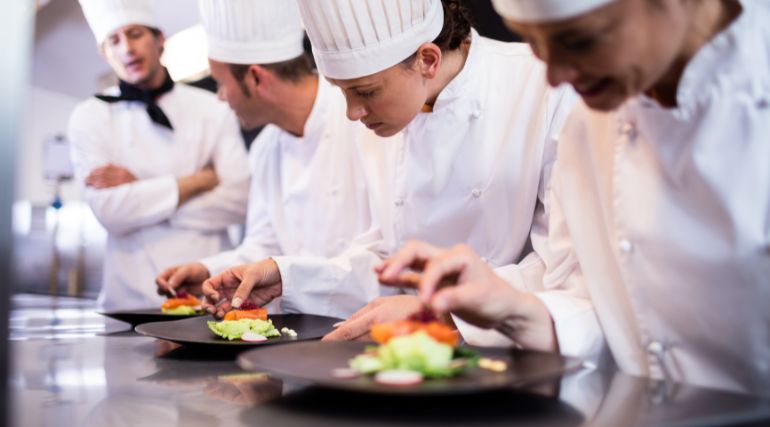10 Chefs Who Changed The World!
Every time you dine out, you draw on hundreds of years of culinary tradition. While chefs nowadays frequently pioneer new culinary techniques, there are others who lived and passed away centuries ago who helped establish fine dining as we know it today.
Although eating has undoubtedly been a part of human existence for as long as there have been humans, the idea of "elegant dining" is relatively recent. Sure, the ancients would have elaborate feasts, but most of the time they consisted of straightforward roast meats and seasonal vegetables served "family style." By the time the Renaissance arrived, full-time chefs employed by wealthy families were producing exquisite and sophisticated culinary delights which only the rich could afford, a prequel to modern super-expensive restaurants. Over the years, the wealthy developed even more convoluted ways to display their wealth through food.
The printing press, however, was the device that had the most impact on good dining. Chefs would now convey their skills and recipes to the kitchens of anybody with access to one of their books after spending years toiling away in kitchens refining new dishes and winning over their employers. All of a sudden, intricate sauces, meat and vegetable combinations, and other dishes that are now well-known started to appear on chefs' menus across the world. Epicures and gastronomes like Brillat-Savarin and Grimod were writing about the pleasures of eating great cuisine while cooks first formalized recipes and procedures. Together, they produced nothing less than a gastronomic revolution.
Although many of the delectable meals and decadent sauces created by the great French chefs of the past have regrettably fallen out of favor today, their culinary influence is still evident in almost every kitchen in the globe, from appropriate knife skills to braising techniques. These chefs may not be household names, but they are individuals who everybody who has ever exhibited an interest in cooking (or simply dining out) needs to be familiar with. Without them, the world of cuisine would be pretty different.
Marie-Antoine Careme
Marie-Antoine Carême, a Frenchman who is regarded as the father of French cuisine and a pioneer of haute cuisine, cannot be overstated in terms of his significance for contemporary Western cuisine. Carême's real legacy came from his systematization, rationalization, and professionalization of French cuisine in the early 1800s. He is best known today for the magnificent sculptures of sugar, marzipan, and pastry known as pièces montées, which are still served in fine dining but are more frequently made of chocolate now.
Although names like Escoffier, Soyer, Point, Vergé, and Bocuse are mentioned (and are noteworthy in their own right), Carême was Haute cuisine's original master. French cuisine continues to be one of history's best-documented cuisines. He was the first to separate this opulent, meat-heavy, ostentatious, and more labor-intensive food from traditional French home cookery. He was also the first to categorize and arrange it so that future generations might readily understand it. He extrapolated four fundamental sauces, referred to as "mother sauces," from a very disorganized collection of recipes and methods. These sauces served as the foundation and garnish for hundreds of meals. Along with many other culinary advancements, Marie-Antoine Careme is credited with creating the appearance of the contemporary chef uniform. In order to go along with his "high art" French cooking, known as haute cuisine, he intended to develop a style of attire that would professionalize the culinary arts.
Georges Auguste Escoffier
Professional kitchens with a high level of skill have a reputation for being rigorous, military-style operations that produce elaborate, precisely timed works of art. All of it is due to the kitchen brigade system established by Georges Auguste Escoffier, known as the "emperor of cooks," in the late nineteenth century.
Brigade de cuisine, often known as the kitchen brigade system, is a hierarchical structure that establishes roles for each station in a professional kitchen. Georges Auguste Escoffier is credited with creating the system, which was initially used in the kitchen of London's Savoy Hotel. Kitchen Brigade is mainly seen as a tribute to expertise and organization while being comprehensive and formal.
Here is a thorough list of brigade-style kitchen personnel, which may be seen in many forms in every contemporary restaurant kitchen.
|
Aboyeur |
Boucher |
|
Boulanger |
Chef de cuisine |
|
Ched de partie |
Commis |
|
Demi-chef |
Entremetier |
|
Friturier |
Garde manger |
|
Grillardin |
Patissier |
|
Plongeur |
Saucier |
|
Sous chef |
Tournant |
Paul Bocuse
A founding father of the nouvelle cuisine movement that transformed dining in the 1960s and 1970s was the chef and restaurateur Paul Bocuse, often known as the "pope of French cuisine."
Over the course of their nearly 50-year career, he not only served as a spokesperson for the cuisine of his own country but also represented and promoted his trade internationally. He founded the Bocuse d'Or, widely recognized as the most prestigious cooking competition in the world, and is known as the father of Nouvelle Cuisine. But as one of the first chefs to effectively use the media, he was able to shed light on the world of commercial kitchens and eateries, permanently altering how the general public views cooking.
Adolphe Dugléré
It's challenging enough to operate one of London's best Michelin-starred restaurants; it's much more challenging to oversee outlets in France while doing so. Hélène Darroze, on the other hand, makes it seem simple by making sure that every aspect of the dining experience at each of her establishments is seamless and centers it on the amazing cooking that was inspired by her upbringing.
Be careful not to try to be a guy in the kitchen. Hélène Darroze has always advised young women entering her career to do this. She ought to know, being a member of a select group of renowned women chefs who have been pushing the envelope in a field dominated by men. When her eponymous restaurant at London's The Connaught reached Michelin's coveted three-star club last week, Darroze made headlines once more.
Alexis Soyer
It seems enjoyable to continually chuck wood into the fire and cook over an open flame, doesn't it? No? What if perishables had to be consumed on the same day they were opened? Not according to Alexis Soyer either. He invented cold water refrigerators, programmable oven settings, and cooking using gas ovens. In addition, he created the concept of the soup kitchen, assisted the millions of Irish people stricken by the Potato Famine, and developed a cookbook intended for regular people.
He contributed to the design of the kitchens and implemented several advances; the kitchens were so well-known that guided tours were offered within. The government instructed Soyer to set up soup kitchens in Ireland in 1847 to aid in easing the famine there, and he traveled to Scutari during the Crimean War to reorganize the hospital catering. Soyer published a variety of cookbooks. A Shilling Cookery for the People (1855) was a cookbook written for common people who couldn't afford expensive kitchenware or a lot of unique materials.
Chefs of today that are changing the world's kitchens
Alain Ducasse
Alain Ducasse, who possesses 17 Michelin stars at the moment, is known for breaking Michelin star records. He now holds the record for the most Michelin stars among chefs who are still alive.
He has developed a business empire over the years with 36 restaurants spread out throughout the world and is regarded by many as one of the top chefs in the world. He is also one of just two chefs to have earned 21 Michelin stars over the course of their careers, and he was the first chef to run restaurants with three stars across three different locations.
Pierre Gagnaire
Pierre Gagnaire, another well-known French chef, has spent his 40-year career amassing Michelin stars. He was barely 26 years old when he won his first star and hasn't stopped since. He grew up in his family's Michelin-starred kitchen. The Michelin guide describes this maverick chef, known for upending the rules of traditional French cooking, as being "in the vanguard of the fusion cuisine movement."
A real accomplishment in the culinary world, Gagnaire's eponymous flagship restaurant in Paris' Rue Balzac has kept three Michelin stars for more than 20 years. Currently, he is in charge of 18 fine dining establishments around the globe, including Sketch in London, one of Mayfair's best Michelin-starred eateries.
Anne-Sophie Pic
Let's support the ladies! With eight stars spread over her five restaurants, Anne-Sophie Pic is the female chef with the greatest Michelin recognition.
When she took over running her family's restaurant Maison Pic after her father passed away in 1997, this French cook lacked proper culinary training. After receiving three stars for her first establishment, Pic built a second eatery, Restaurant Anne-Sophie Pic, which honors the Valence-born culinary heritage of her family. It seeks to exhibit the creative energy that, in the words of the Michelin Guide, "binds the history of the Pic family with that of French gastronomy."
Gordon Ramsay
Gordon Ramsay, possibly the most well-known chef in the world, is renowned for his erratic behavior in the kitchen and outstanding British food. Although he has received 16 Michelin stars over the course of his career, he only has seven at the moment. The longest-running three Michelin-starred restaurants in London is his namesake eatery, Restaurant Gordon Ramsay, which has held three stars since 2001.
The 35 restaurants owned by the Scottish-born chef, restaurateur, and television personality are spread all over the world. He has established a thriving business by appearing on television screens all throughout the English-speaking world. . The majority of Gordon Ramsay's projected $220 million net worth as of 2020 comes from his well-liked TV programs, including Hell's Kitchen, Kitchen Nightmares, and Master Chef.
Yoshihiro Murata
This Japanese chef, a culinary superstar, has been promoting Japanese food for close to 50 years and has four restaurants around the globe. He also has seven Michelin stars. As part of Asia's 50 Best Restaurants awards program, he was recognized as the maestro of kaiseki cuisine and given the prestigious American Express Icon Award in 2020.
Murata is the third-generation proprietor of Kikunoi, a three-Michelin-star ryotei (high-end Japanese restaurant) in Kyoto that has been in his family for 100 years. There, he pays homage to his forefathers' traditional kaiseki cuisine by using a contemporary and innovative style.
Murata's most recent endeavor, Tokimeite, a genuine Waygu restaurant in Mayfair, shows that he is expanding his knowledge internationally. His culinary empire's growth in Europe is not the only indication of his success on a worldwide scale. When he was 30 years old, Heston Blumenthal, another chef on this list with a Michelin star, went to Japan to study under Murata. The well-known British chef credits Murata with having influenced his approach to cooking.
Be a part of the culinary history!
Do you wish to contribute significantly to upscale dining and home cookery in the future? With our course finder, find the program in hospitality management that best suits you, anywhere in the world. Discover the basics of cooking, the craft of presentation, and the business of managing a restaurant. Additionally, you may be on your way to winning over clients and critics owing to the year-round classes that many institutes provide! It could turn out to be the best choice you ever make!












